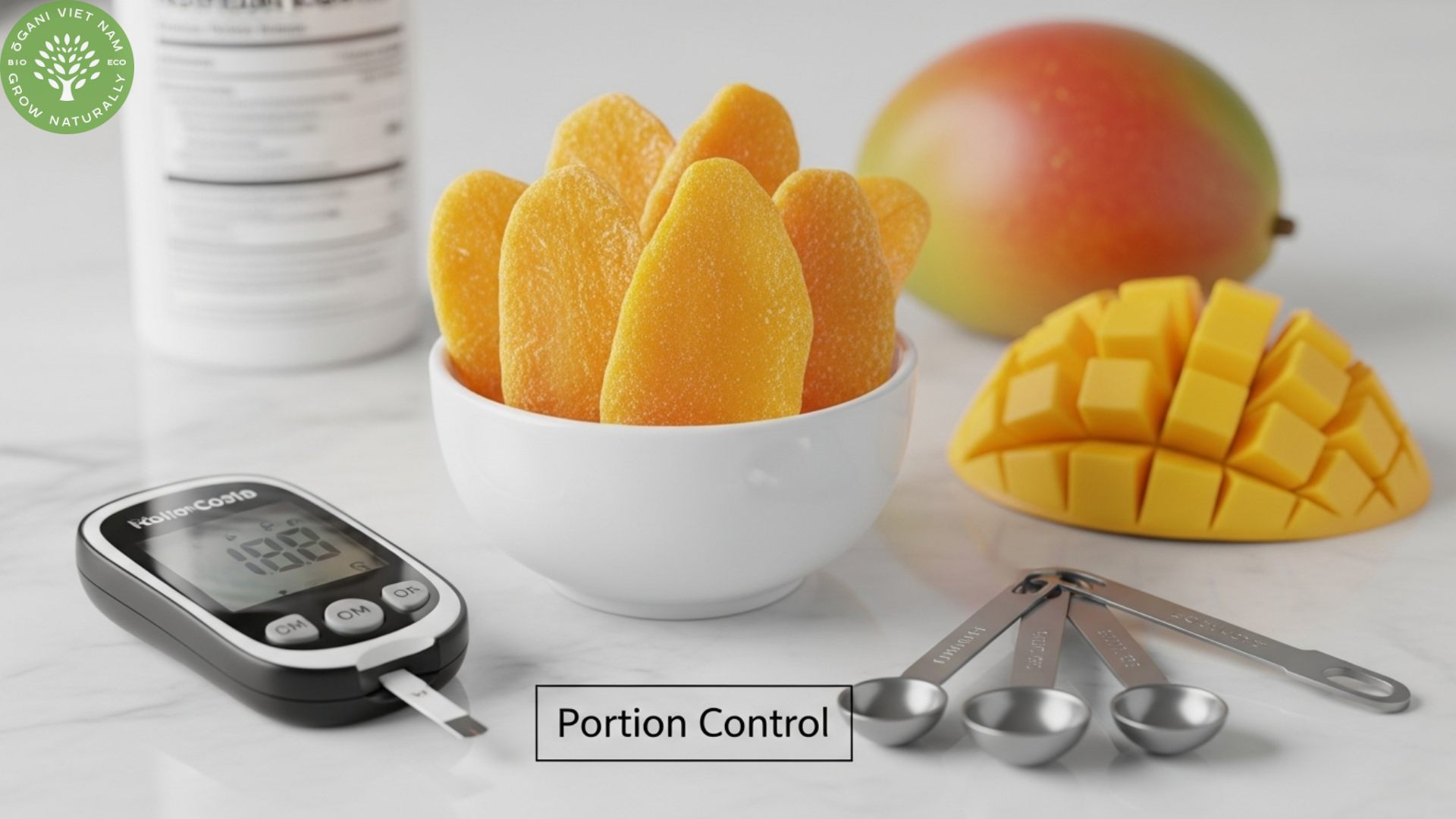
Dried Mango Diabetes Guide reminds us that even if you have diabetes, you don’t have to say goodbye to the sweet taste of mango. With a glycemic index around 60, dried mango has a moderate effect on blood sugar. But when you enjoy it in the right way—just a small handful (20–30g) at the right time—it can actually be a safe and nourishing snack. At Ogani VN, we’ve walked with many diabetic customers, showing them how to bring our premium dried mango into their daily meals while still staying true to their health journey.
Dried Mango Diabetes Guide: Understanding Blood Sugar Impact
The truth is, the link between the dried mango diabetes guide and how your blood sugar actually reacts is not as simple as people often believe. Once you take the water out of fresh mango, all the natural sweetness is packed into a much smaller bite. Just 40g of dried mango can carry around 28–32g of natural sugars—that’s like eating one and a half mangoes in only a few chews.
But what surprised me most during our product testing at Ogani VN was this: the fiber doesn’t just disappear. Thanks to our low-temperature drying, most of it stays right there. And that fiber matters—it works like a little brake system for your body, slowing down how fast the sugar flows into your blood. It won’t erase the sugar, but it helps avoid those sudden spikes that can make things difficult for people managing diabetes.
I also came across research in the British Journal of Nutrition showing that people who had just 10g of freeze-dried mango every day for 12 weeks actually saw their blood sugar levels drop. Of course, that was freeze-dried, not sun-dried, and the portion was tiny—much smaller than what most of us would enjoy as a snack.
So what’s the real takeaway? It’s not about avoiding dried mango completely—it’s about portion, timing, and balance. I’ve seen with my own eyes how many of our customers manage their diabetes well and still enjoy our dried mango. The difference is, they do it with care and intention, not casually.
Dried Mango Diabetes Guide: Glycemic Index and GI Considerations
With a glycemic index of 60, dried mango sits right in the medium range. That means it raises blood sugar at a steady, moderate pace—not as sudden as white bread (GI 75), but not as gentle as an apple (GI 36) either. Still, the GI number is just one piece of the puzzle when it comes to a complete dried mango diabetes guide.
What really makes the difference for people living with diabetes is the glycemic load—because it reflects both the type of carbs and the actual amount you eat. For example, a 20g serving of our dried mango carries a glycemic load of around 12. That’s also moderate, but when you compare it to a slice of white bread (GL 10), you can see why portion size is so important. Just a little too much can easily tip the balance.
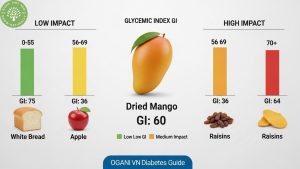
Interestingly, research shows that fresh mango often leaves people feeling fuller and leads to lower post-meal blood sugar compared to dried mango. That doesn’t make dried mango “bad”—it simply means we have to be a little wiser with how much and when we eat it, especially for diabetes management.
The American Diabetes Association actually lists dried fruit as an acceptable food, but with one clear reminder: keep the portion small, about 2 tablespoons (around 15g of carbs). Many of our customers who stick to this guideline share that their blood sugar stays steady when they check their readings afterwards. It’s proof that with awareness and balance, you don’t have to give up the tropical sweetness you love.
Essential Portion Control in Your Dried Mango Diabetes Guide
Getting portion sizes right is often the hardest part when it comes to dried fruit—and it’s absolutely essential if you’re following a dried mango diabetes guide. Because dried mango is so concentrated, it’s surprisingly easy to overeat. I’ve seen people absentmindedly finish 100g while watching TV, not realizing that means almost 85g of sugar in one sitting.
What truly helps our diabetic customers is keeping it simple: stick to 20–30g per serving (around 6–8 slices of our dried mango) and count it as part of your daily carbohydrate plan, not as an endless “healthy” snack. One practical trick? Pre-portion your servings into small containers or bags. It may feel small, but it’s a powerful way to avoid the temptation of going back for “just one more.”
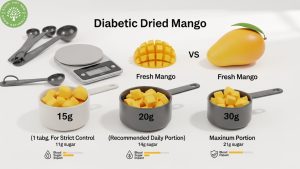
Timing makes a huge difference. When dried mango is eaten on its own, the sugar hits your system more quickly. But if you pair it with protein or healthy fats—as part of a balanced meal—it can soften that impact. Some of our customers enjoy mixing a few slices into Greek yogurt or eating them with a handful of nuts. The result is a snack that feels satisfying without sending blood sugar on a rollercoaster.
Still, diabetes is deeply personal. What keeps one person’s glucose steady might trigger a spike for someone else. That’s why we always encourage testing your blood sugar 1–2 hours after trying dried mango. It’s the simplest way to know how your body responds—and it gives you the confidence to enjoy it wisely.
Dried Mango Diabetes Guide: Fresh vs Dried Comparison
The fresh-versus-dried question always brings out some surprising truths that any dried mango diabetes guide needs to explain clearly. On paper, the difference looks huge: fresh mango has around 14g of sugar per 100g, while our dried version holds nearly 70g in the same weight—a fivefold jump that sounds alarming.
But numbers don’t tell the whole story until you think about how people actually eat. A typical serving of fresh mango is about 150–200g (one medium fruit), which means you’re getting 20–28g of sugar in one sitting. With dried mango, a reasonable 30g portion carries about 21g of sugar—almost the same, just in a smaller, lighter package.
So, the real issue isn’t that dried mango is “too sweet,” but that it’s so easy to overeat without noticing. That’s why awareness and mindful portions make all the difference.
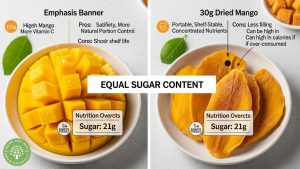
Fresh mango does have clear advantages when it comes to managing diabetes. The higher water content helps you feel full more quickly, and because the fruit’s natural structure is still intact, your body needs more effort to release the sugars—slowing down absorption in a way that’s naturally protective. On top of that, fresh mango keeps more vitamin C and other water-soluble nutrients that often get reduced in the drying process.
That said, dried mango has its own strengths you can’t ignore. It’s shelf-stable, easy to carry, and convenient to portion—things fresh fruit can’t always guarantee. Here in Vietnam, I’ve watched many customers struggle during mango season, trying to finish their fruit before it spoiled, sometimes pushing themselves to eat overripe mangoes that spiked their blood sugar.
So what’s the verdict? If you can find good-quality fresh mangoes and consistently keep your portions in check, fresh is usually the better choice for blood sugar balance. But dried mango still has a rightful place in a diabetic diet—as long as you enjoy it mindfully and with intention.
Practical Dried Mango Diabetes Guide: Diet Integration Tips
Bringing dried mango into a diabetic meal plan isn’t just about self-control—it’s about having the right strategy. From listening to our customers and working with nutrition experts, we’ve seen a few simple approaches make a real difference in keeping blood sugar steady.
One of the most effective is pairing dried mango with protein or healthy fats to slow down sugar absorption. Some customer favorites include stirring a few chopped pieces into plain Greek yogurt, enjoying it alongside a handful of almonds, or tossing it into a salad with an olive oil dressing. These small combinations don’t just balance the glycemic response—they also turn dried mango into a more satisfying, wholesome snack.
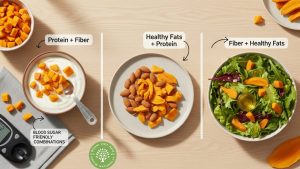
Timing matters more than most people realize. Many diabetics tell us that a small portion of dried mango feels best right after exercise, when muscles are ready to use glucose more efficiently. Others prefer it at breakfast, knowing they’ll have the whole day to burn through those natural sugars with normal activity.
Another key is to treat dried mango as a replacement, not an extra. If you add it to your diet, make a small adjustment elsewhere—maybe a little less rice at dinner, or skipping another piece of fruit if you’ve already had your dried mango portion. That way, your overall carb balance stays on track.
And don’t forget hydration. Because dried fruit naturally lacks water, it can leave you feeling a bit dehydrated. More importantly, dehydration itself can make blood sugar harder to control. That’s why we always suggest drinking extra water when enjoying our dried mango—not just for digestion, but for better glucose management overall.
Dried Mango Diabetes Guide: Frequently Asked Questions
Can diabetics eat dried mango every day?
Yes—if the portion is small (about 20–30g) and it fits within your daily carb allowance. The key is listening to your body and checking your blood sugar response. If you’re on insulin or other glucose-lowering medication, it’s best to talk this over with your healthcare provider before making dried mango a daily habit.
How does dried mango compare to other dried fruits for diabetes?
Dried mango has a moderate glycemic index of around 60, which is close to raisins but higher than dried apricots (GI 30–35). It falls in the middle when compared to dates (GI 55) or sweetened dried cranberries (GI 64). The most important tip is to always choose unsweetened varieties and control your portions.
Should I avoid dried mango if I have prediabetes?
Not necessarily. You don’t have to cut it out completely, but you should be extra mindful. Stick with smaller servings (15–20g) and try to pair it with protein or fiber-rich foods—like nuts or yogurt—to help steady your blood sugar.
What’s the best time of day to eat dried mango if I have diabetes?
Morning or after exercise usually works best. That’s when your body is more insulin-sensitive and can process the natural sugars more efficiently. The one time we’d suggest avoiding it is late at night, when activity is low and insulin sensitivity drops.
Does the processing method affect blood sugar impact?
Yes. Freeze-dried mango often has a gentler effect on blood sugar compared to sun-dried, because the freeze-drying process keeps more of the fruit’s structure intact. Still, with both types, portion control is what really makes the difference.
Your Complete Dried Mango Diabetes Guide: Making Smart Choices
Managing diabetes doesn’t mean giving up the flavors you love—it means learning how to enjoy them with wisdom and balance. Our dried mango diabetes guide is here to remind you that with the right portion, smart timing, and a little self-awareness, dried mango can still be part of your life in a safe and nourishing way.
At Ogani VN, we don’t just offer premium dried mango—we want to walk beside you on your health journey. That’s why we keep our products unsweetened and naturally processed, so you get the pure taste of mango with the nutrition intact, without the added sugars or artificial ingredients that can make blood sugar harder to manage.
If you’re curious, begin gently—with a small sample pack, see how your body responds, and always keep your healthcare provider in the loop. Because eating well with diabetes isn’t about restriction—it’s about making mindful choices that let you feel both safe and satisfied. Visit our website or connect with our nutrition team—we’d love to help you discover how sweet balance can be.
Read more:

